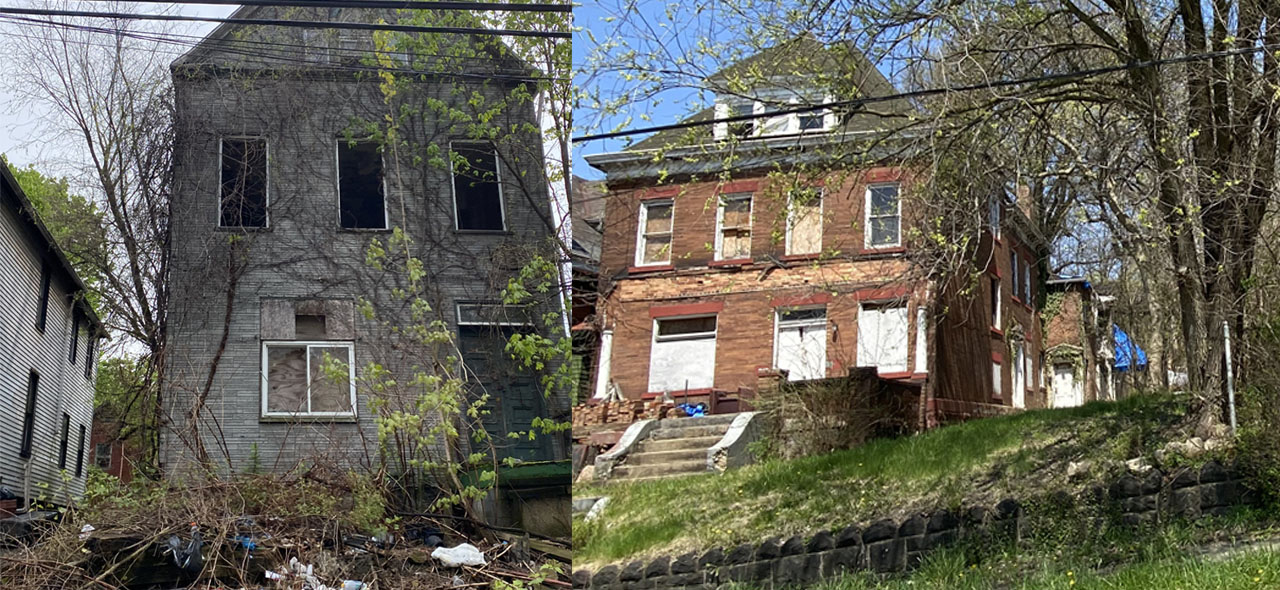Opportunity Awaits, but…
10 Years After Land Bank Legislation, Pittsburgh Tackles Blight at a Snail's Pace

May 30, 2022
Kendell Pelling knows vacant and blighted property. For more than 15 years he was in charge of land recycling at East Liberty Development, Inc. There, he saw how, even in a real estate market that was heating up, new houses priced to sell couldn’t find a buyer when blight was nearby. But once the abandoned and neglected homes and lots were rehabilitated, they sold like hotcakes.
“Most of those vacant and abandoned properties that were pushed through the system have been permanently recycled,” said Pelling, now executive director of a new nonprofit, Rising Tide Partners, which helps neighborhoods turn abandoned properties into assets. “They’re back on the tax rolls. There are new houses sitting on them, houses being built on them. There is market-rate housing, affordable housing, public housing, community gardens and parks on those lots.”
The battle against blight in southwestern Pennsylvania is largely being waged at the grassroots level by nonprofits ranging from housing advocates to community development groups and land banks. And they’ve shown that abandoned, tax-delinquent houses and lots can be reclaimed to the benefit of communities large and small.
But they’re not being recycled at a scale anywhere near the size of the inventory of vacant and blighted properties in the region. Ten years after Pennsylvania’s land bank law was passed, raising hope that blight could be tamed, many of the hurdles to recycling these properties remain.
Land banking legislation and changes to Pennsylvania’s property laws enacted over the past 10 years offer more options for getting control of vacant property. But the legal processes involved in acquiring it remain tedious, risky and expensive. And state legislation aimed at winning the battle against blight failed to include a sustainable means of financing the work, narrowing the scope of local efforts to repurpose abandoned houses and lots.
‘LIKE CANCER’
Properties go vacant for many reasons including unpaid taxes, high cost of repairs, homeowner financial trouble, the death of a property owner and business failure. Dysfunctional markets with low property values and slim chances of resale contribute to the problem. Vacancy is a private-sector issue that has become an expensive public problem.
Although the various methods of measuring vacancy are imprecise, they all reveal a broad, lingering problem here. In 2020, Allegheny County had more than 51,000 vacant housing units, including unoccupied apartments, according to U.S. Census Bureau estimates. Vacancy has consistently claimed about 10 percent of available housing in Allegheny County over the past five years. The vacancy rate is 11.5 percent across the seven-county Pittsburgh Metropolitan Statistical Area. In Pennsylvania as a whole, it is 10.6 percent.
In Allegheny County, vacancy is most concentrated in the Monongahela River valley and in Pittsburgh neighborhoods that have experienced severe population loss and lack of investment. More than 20,000 vacant lots and nearly 15,500 vacant houses and apartments exist in 41 municipalities in the Mon Valley and eastern suburbs, according to a study commissioned by the Steel Rivers and Turtle Creek Valley councils of government.
The city of Pittsburgh has nearly 24,000 vacant properties, including 7,500 vacant houses and buildings, according to a market analysis by the Center for Community Progress, a national land-recycling nonprofit. About 22 percent of the vacant houses and buildings are owned by the city.
“The challenge is the legacy of populations that peaked in the 1960s,” said Lance Chimka, director of Allegheny County Economic Development. “Some of our communities have lost 75 percent of their population. They don’t need all of the housing they have. We still have a fundamental supply-and-demand imbalance, which is hard to rectify. You also have the challenge of more-desirable neighborhoods not having enough housing and less-desirable neighborhoods having too much. It’s not in the right places.”
After the blight study undertaken by the Steel Rivers and Turtle Creek Valley councils of government, 26 municipalities joined the Tri-COG Land Bank to address the problem.
“Everybody knows the communities that are struggling,” said An Lewis, executive director of the Tri-COG Land Bank. “What was revealing was the pockets of blight in communities that aren’t struggling. Blight is like cancer. If left unattended, it will grow. Nobody would look at Monroeville and say it’s a distressed community. But we do a lot of work there. Monroeville is an active member of the land bank because they know they have to take care of that vacant property in a stable neighborhood, so it doesn’t become a community overrun by blight.”
Doing that continues to be difficult for government and nonprofits alike, even for the 25 Pennsylvania land banks expressly focused on recycling vacant properties that sap tax revenue, create eyesores, drive down property values, and consume local police, fire and maintenance services.
LEGAL MAZE
One nagging bottleneck is getting their hands on tax-delinquent, abandoned property — the first step toward recycling them. “If you don’t control the property, you don’t control anything,” Pelling said.
To get tax-delinquent properties in the city of Pittsburgh, buyers must wind through a treasurer’s sale process that a 2019 city controller’s investigation found to be slow, getting slower and understaffed. Even after a treasurer’s sale, the buyer must secure clear title, which also takes time and money. In the rest of the county, vacant, tax-delinquent properties are typically acquired through sheriff’s sale, in which the successful buyer comes out with clear title.
Nonprofits are aggressively buying properties to secure affordable housing in Pittsburgh’s Hazelwood neighborhood. A major technology hub is taking root on a former steel mill brownfield and the neighborhood is poised for rebirth after decades of population loss and disinvestment. Home prices are already rising. The nonprofits hope that expanding the affordable housing inventory will prevent widespread displacement of residents who otherwise might be priced out of a hot housing market.
Hazelwood has plenty of vacant property to work with. Nearly one-third of its property is vacant, including nearly 800 residential properties. But the nonprofits have shied from rehabbing vacant properties. The city process of acquiring them has been too difficult, slow and risky. Hazelwood Initiative, the neighborhood community development corporation, has acquired only 10 of the 800 available vacant houses — and for good reason. The three it most recently acquired took three years to move through the city process. The idea was to rehab them as affordable single-family houses to help bolster homeownership in a neighborhood where 52 percent of residents rent. “But they had deteriorated to the point that our engineer said we need to tear them down,” said Hazelwood Initiative Executive Director Sonya Tilghman. “They weren’t that way when we asked to purchase them.”
Rising Tide Partners is avoiding the city’s process of acquiring vacant properties in favor of trying to gain control of them through the state conservatorship law. The law enables community groups and others to petition the court to be named conservator of a vacant property. Judges have discretion to clear the property of debts and transfer ownership if the plan for reusing it is approved, and the buyer is able to pay its assessed value and meet other legal requirements. In many cases, it is quicker than going through the city treasurer’s sale. Rising Tides over the past two years has taken control of or is in the process of acquiring about 190 vacant properties in six city neighborhoods, including Hazelwood.
But, Pelling said, “It takes a lot more money and work on the front end. We have to pay for legal work and do more property research upfront. When you go to the court, you have to bring an appraisal of what the property is worth. If you’re appointed conservator, you have to have the money and capacity to clean it up, clean it out, put a new roof on it, whatever it takes to stabilize it. And you have to do it immediately. That’s different than going through tax foreclosure.”
State and local governments in Pennsylvania so far have been bit players in the battle to turn blight into community assets.
Allegheny County’s new Blight Removal Program, which covers demolitions, has spent $1.9 million so far to raze 100 properties. But the primary way the county recycles tax-delinquent, vacant properties is through its Vacant Property Recovery Program. It takes vacant properties in participating municipalities through eminent domain. In Braddock, Fifth Season, a new vertical-farming plant that is expected to employ up to 60 people, sits on properties the program recycled.
The program recycled 84 properties last year, a sliver of the tens of thousands of vacant properties in the county. “It’s not a high-volume program for the magnitude of the problem,” Chimka said.
UNFULFILLED POTENTIAL
Land banks were billed as a way to take a bigger bite out of vacancy and blight when the state adopted a law in 2012 that allowed them to be created. They’re designed to streamline the buying process by assembling portfolios of ready-to-sell, reasonably priced properties with titles cleared and back taxes forgiven under agreements with school districts, municipalities and other taxing authorities.
Not included in the legislation was a dedicated source of funding. Land banks are left to figure out where to get the money and, for most, the scope of their work has been limited by difficulties raising sums sufficient to deal with the scale of the problem.
The two land banks in Allegheny County operate with budgets that amount to a fraction of what vacancy and blight cost municipalities, taxpayers and property owners.
Vacancy and blight consume upwards of $10.7 million a year in code enforcement, police and fire services in the 41 Allegheny County municipalities covered by the Steel Rivers and Turtle Creek Valley councils of government.
Municipalities lose $8.6 million to delinquent property taxes. Nearby properties lose up to $247 million of their value, which robs municipalities of another $9.7 million in tax revenue, a blight analysis commissioned by the two COGs suggests.
The Tri-COG Land Bank in those communities operates on a budget just under $1 million, which is cobbled together from membership fees, sales, grants and other sources. Its staff, most of which is shared with the COGs, amounts to five full-time positions. The most successful of the two land banks in the county, it has sold 29 of the vacant properties it acquired for reuse since 2018 and is zeroing in on acquiring about 40 others.
“We can be a sustainable organization,” Lewis said. “We can be fiscally responsible. We can expand programming. But it’s going to continue to require being subsidized. This is never going to be a profit-making activity.”
The Pittsburgh Land Bank, by comparison, has been ineffective. Its job, as described on its own website, is to “make it faster, easier and cheaper for responsible new owners to fix up blighted, abandoned properties and get them back into the market and onto the tax rolls.” During its first seven years, it only managed to acquire and transfer one vacant lot to a new owner.
Vacant properties cost the city more than $9 million a year in services, tax delinquency and lost revenue. And that vacancy is blamed for $266 million in lost property value, a city blight study suggests.
The land bank, which was started as an independent corporation under a 2014 city ordinance, has struggled with organizational, legal and funding issues. Its dismal record of recycling property has been widely criticized, particularly among nonprofits who had hoped it would become an effective weapon against blight in their communities.
This could be a defining moment for the beleaguered land bank, said Diamonte Walker, who was its executive director for 12 months until April, when she left to become the inaugural CEO of the nonprofit Pittsburgh Scholar House.
During that time, the land bank became an affiliate of the Urban Redevelopment Authority of Pittsburgh. It has been given a $10 million cut of the $74.9 million the URA received from the city’s share of American Rescue Plan funding. It has begun hiring its first full-time staff. And it has started the legal work to acquire about three-dozen vacant, tax-delinquent properties out of a batch of 175 that had been requested by community groups as far back as six years ago.
“I know people are frustrated with the land bank,” Walker said. “It can do better. I think [the land bank] is on the verge of turning the corner. But, while I’m very optimistic about what that $10 million infusion means, it’s a temporary fix, not a long-term substitute for sustainable funding.”
Allegheny County hasn’t yet invested any of its $380 million share of American Rescue Plan funds in recycling vacant houses and lots. The county’s approved spending plan for the first $100 million does not include its Vacant Property Recovery Program. The county has until the end of 2024 to decide how to spend the rest of the federal money.
The Vacant Property Recovery Program recycles up to 100 vacant, tax-delinquent properties a year at a cost to the county of about $500,000 in Economic Development staff time, legal work and other expenses, Chimka said. An example of what can be done when state and local governments prioritize and significantly invest in recycling vacant property can be found in Cleveland. The Cuyahoga Land Bank razed 7,000 vacant properties, rehabbed more than 2,100 vacant houses and returned 11,500 distressed properties to the tax rolls during its first 10 years. The value of nearby homes increased by $735 million. Every dollar the land bank spends generates $8 in local economic benefits, according to an independent economic impact analysis.
On a budget of roughly $10 million a year, the Cuyahoga Land Bank supports a staff of more than 30 people and has the capital to acquire, maintain and rehabilitate hundreds of vacant properties a month, even abandoned shopping centers. As much as $8 million of its budget each year is generated by an Ohio law that allows counties to give land banks a share of the penalties and interest collected in delinquent property tax settlements.
It’s a law Pennsylvania doesn’t have. “Cuyahoga County, Ohio land banks have dedicated money. That’s the trick,” Lewis said. “Short of that, a strategy alone isn’t going to solve the problem. We all know blight is bad. We know where it is, how much there is, what needs to be done. We’re doing things incrementally. We need to be able to do more than that.”













